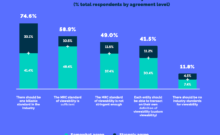The Digital Content NewFronts wraps up today for the seventh year to connect makers of high-quality digital video content with digital ad buyers, and while the event showed its age, with far fewer presenters than in year’s past, the talk about brand safety was no less muted, as media companies tried to take advantage of YouTube’s PR crisis . Here are five things we learned, plus awards for the best, worst and everything else.
Brand safety was the big theme in almost every presentation
With a steady drip of articles about platforms’ user data being abused and displaying ads on extremist content, the brand safety as marketing message was in full swing at the NewFronts. No neo-Nazi videos to see here, just high quality, wholesome and advertiser-friendly video. The headline at Meredith’s first NewFronts pitch was “high quality content, in brand safe environments, at even greater scale,” said Jon Werther, president of the National Media Group at the publisher behind such wholesome titles as Better Homes and Gardens and Family Circle and newly acquired Time Inc. titles like People and InStyle.
With Facebook battling criticism about how it protects user privacy, Meredith also touted how its shoppable videos can drive people to buy products by knowing their location, but “not in a creepy way.” The pitch may help media companies take share from each other, but if the hope is to induce advertisers to shift some of their spending from YouTube, its sheer size and importance to marketers means it’s less likely to happen.
Hulu and YouTube are still the belles of the ball
More than a dozen companies presented during this year’s NewFronts, including new big-media entrants such as ESPN and Viacom. But as is the case every year, Hulu and YouTube’s presentations were still the most anticipated by most marketers. Why? Because at the NewFronts, no one can compete with the scale that Hulu and YouTube can offer. (Hulu, which has always referred to and programmed its NewFront as traditional, TV-style upfront, announced that it now has 20 million subscribers, with ad-supported subscriptions up 40 percent year over year. YouTube, meanwhile, still has more than a billion daily users.)
Read More at The Original Article: digiday.com









